- Wondering how to get Monopoly GO! free rolls? Well, you’ve come to the right place. In this guide, we provide you with a bunch of tips and tricks to get some free rolls for the hit new mobile game. We’ll …
Best Roblox Horror Games to Play Right Now – Updated Weekly
By Adele Wilson
Our Best Roblox Horror Games guide features the scariest and most creative experiences to play right now on the platform!The BEST Roblox Games of The Week – Games You Need To Play!
By Sho Roberts
Our feature shares our pick for the Best Roblox Games of the week! With our feature, we guarantee you'll find something new to play!All Grades in Type Soul – Each Race Explained
By Adele Wilson
Our All Grades in Type Soul guide lists every grade in the game for all races, including how to increase your grade quickly!
A Planet of Mine Tips, Cheats and Strategies
A Planet of Mine is a strategy game developed by Tuesday Quest. Despite its seemingly small planet habitats and cute voxel creatures, it’s a complex 4x strategy experience that requires careful resource and expansion management in order to complete its …
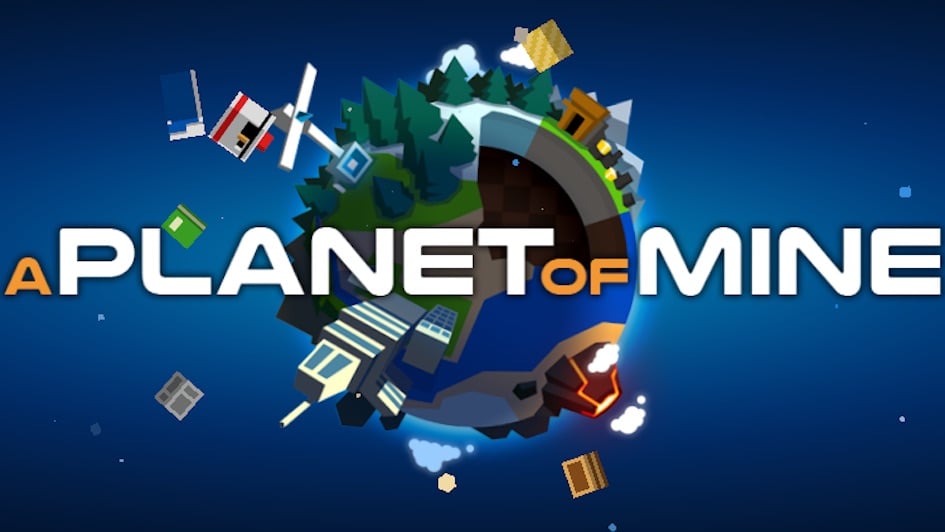
A Planet of Mine is a strategy game developed by Tuesday Quest. Despite its seemingly small planet habitats and cute voxel creatures, it’s a complex 4x strategy experience that requires careful resource and expansion management in order to complete its challenges or just simply survive. Gamezebo’s A Planet of Mine Tips, Cheats and Strategies will help get your new colony off on the right foot so you can focus on interplanetary domination.
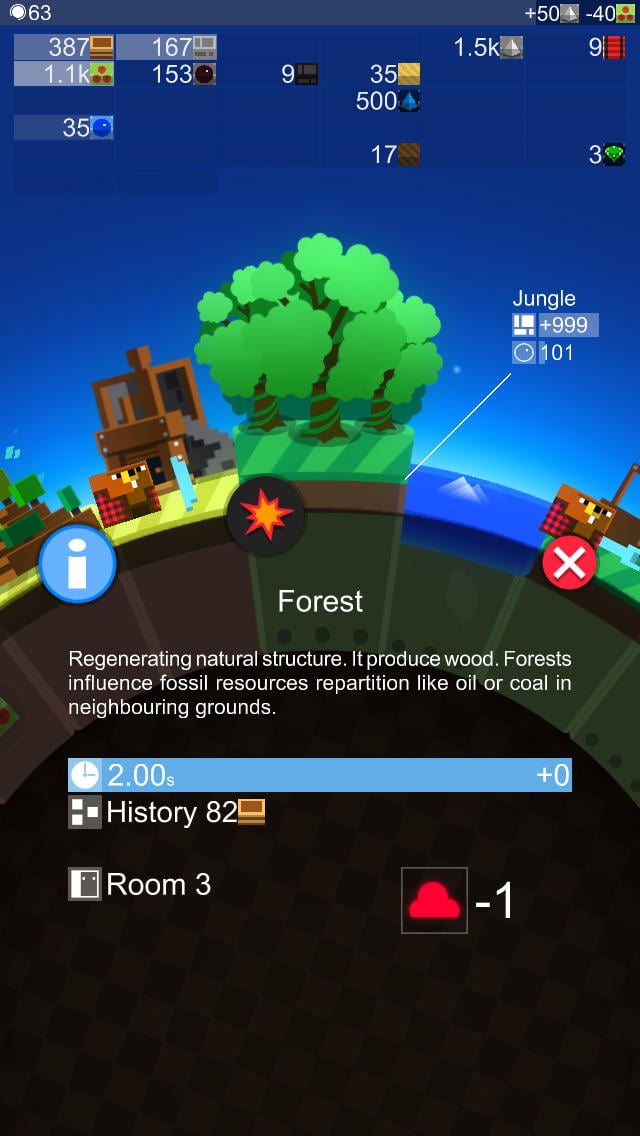
Use the ground view to learn about your planet. Tapping a piece of ground will pull up details on that area, which include: 1) what is currently built there or occupying the space, such as a shed or forest; 2) what type of ground it is, such as jungle or savannah; 3) how many resources are stored within it, both solid and liquid. If a space is occupied, you’ll receive details on the structure in place and any actions regarding it, such as leveling up or demolishing it. If a space is unoccupied, you’ll be given more details about the ground itself, including whether it’s cultivatable and which species prefer working there.
In the image above, we can see 1) a forest is occupying this space; 2) the ground is jungle; 3) there are +999 solid resources and 101 liquid resources available in this section of ground (the block and circle icons underneath “Jungle,” respectively).
Of these, one of the most important details is #3, the resources stored within it. Liquid resources are generally harder to come by than solid, so finding a piece of ground with ample liquid resources indicates you should definitely build a well there and extract the liquid before delegating the space to something else. On the other hand, if you see a piece of ground with zero or very few resources, it’s not valuable to build a well there as you won’t get anything out of it.
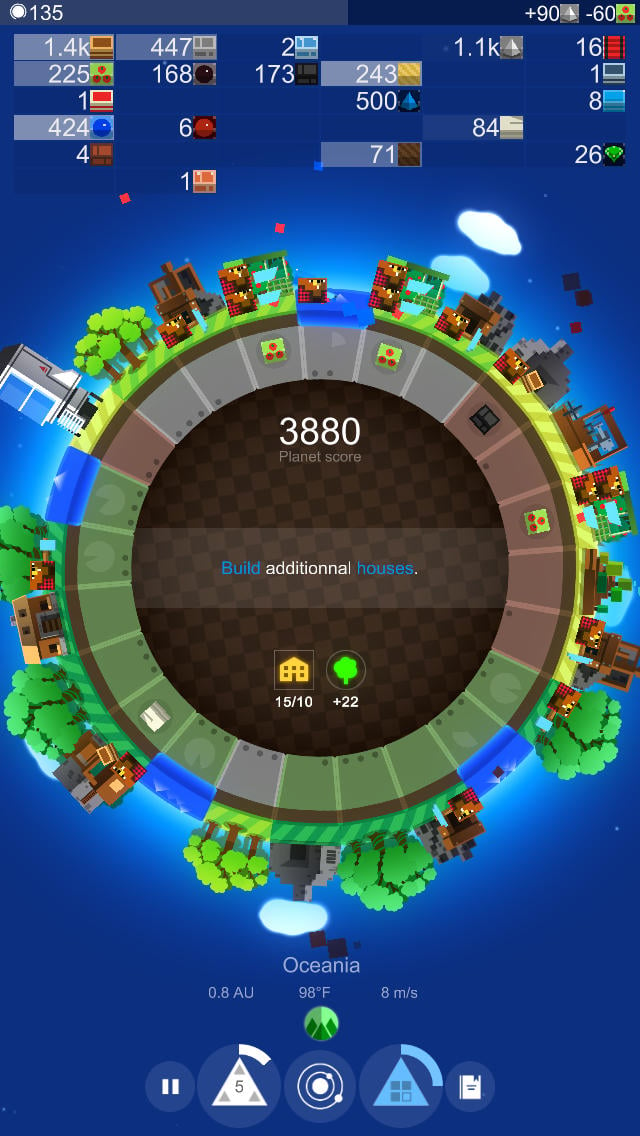
The main planet view gives you a quick glance at your current productivity. When not zoomed in to a specific piece of ground, you’ll be able to see your entire planet and everything that’s currently going on there. From this view, there are a number of shortcut symbols:
- 1) The color of the ground: each type of ground will always be represented by a specific color at its core (below the upper crust). Medium brown is savannah, medium green is jungle, purple is netheriumferous, dark brown is swamp, etc. You can always see these by tapping areas specifically, but this allows you a quick overview and assessment of whether you’re using your population to the best of their abilities. For instance: you want Beaverians working in swamps and Rhinos in savannahs.
- 2) The percentage of natural resources left: if a piece of ground contains a natural resource like forest or sea, there will be a large circle filling most of the ground space. The completeness of this circle indicates how much of that resource is remaining: a full circle is 100% while a tiny sliver means it’s almost entirely depleted. If a natural resource is fully depleted it will not grow back. Some resources, like seas, will never be replenished even if you don’t harvest them for some time.
- 3) The current resource being produced: if a piece of ground contains a species-built structure that produces resources, there will be an icon indicating the resource being produced. For instance, under a farm there will be an icon of redballs. Under a foundry you will see whatever recipe is currently assigned, such as coal or plastic.
- 4) Space for additional workers: the black dots at the very bottom of a piece of ground indicate how many more workers can be assigned to that plot. So, for example, if you have a farm—which can accommodate two workers total—with no one assigned to it, there will be two dots beneath it. Up to three workers can harvest a sea at one time, so a sea with two workers assigned would have one dot beneath it. Structures that do not require workers—such as schools—will have no dots.
- 5) The chunk of ground itself: if the colored core mentioned in #1 is missing—the ground is shrunk to a small sliver—this means all the resources in that ground, solid and liquid, have been depleted. This is an easy way to know at a glance if there are still minable resources remaining in a specific area, although you have to tap the ground in question to know exactly how many.
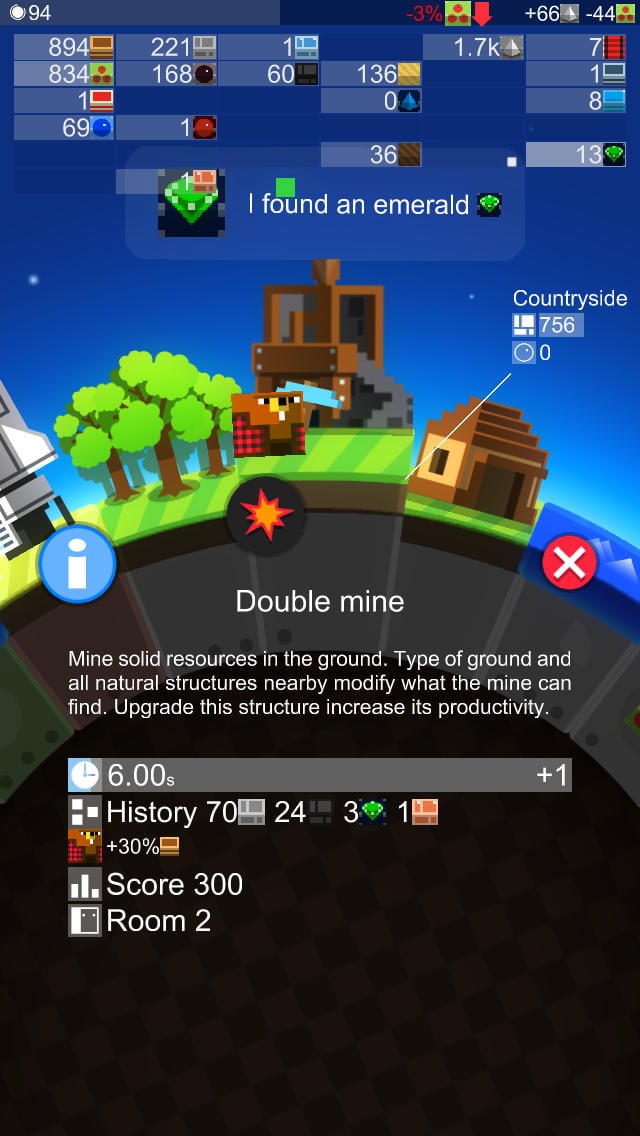
Both the area you’re mining, and its surrounding structures, impact the resources you’ll receive. It makes sense that rocky ground would produce more stone than, say, the jungle. But the objects on the plots of ground directly to the left and right of an area also affect what you will find there. The game provides hints of resource availability within descriptions, but a lot of it can also be figured out by what makes sense. Mining just right of a Pinatosaurus will often result in larger quantities of fertilizer or bio-gaz. Build a well near a sea and you’ll be more likely to collect water. If you’re looking for oil, you’ll want to place your well near vegetation like redball bushes or forests.
Upgrading and building new eventually cost the same: Most structures in the game upgrade into or from another building. Plantations upgrade into farms, which upgrade into staged farms, etc. Resource cost-wise, the totals you will spend on upgrades are equivalent to building an upgraded structure outright. If you have a lower-level structure already in place, upgrading it is cheaper than building a separate plot with the upgraded structure directly, but if you’re building from scratch then you might as well build the upgraded structure and save on construction time.
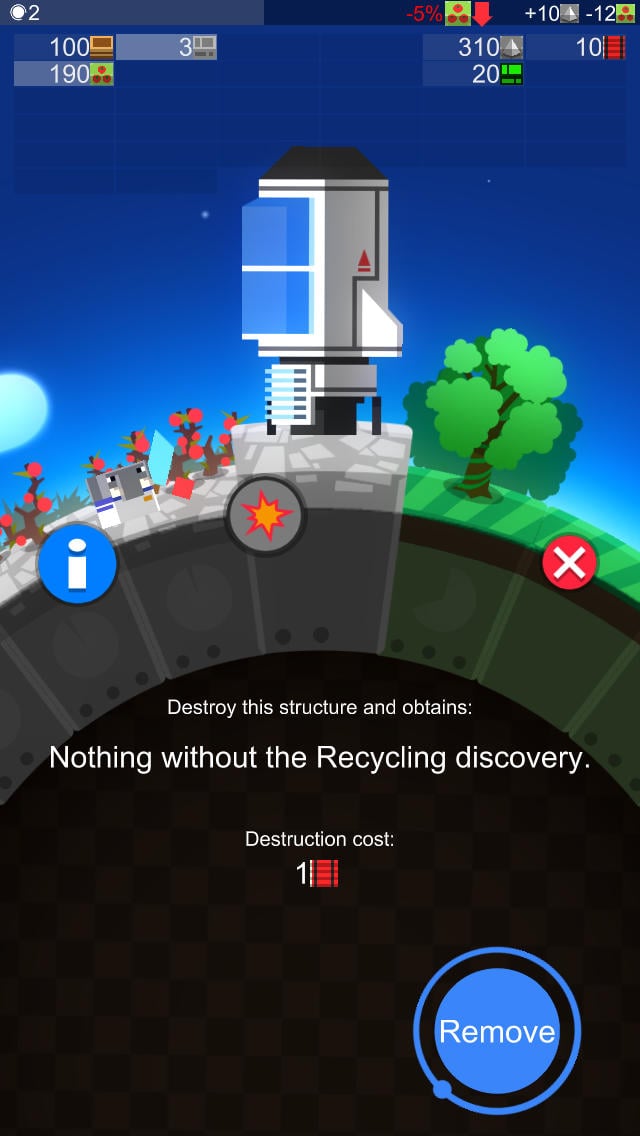
Demolish houses to free up space: Habitats in A Planet of Mine determine how many inhabitants you can create. They do not decide how many can live on your planet at once. If you’re low on space, build up your population by creating as many inhabitants as you can (or can reasonably support), and then demolish the sheds/houses, etc. You’ll still get to keep all of your inhabitants. However, if someone dies or you need more than you have, you’ll need to build up living space again before you can create another citizen.
If you aren’t planning on traveling anywhere for awhile, you can demolish your starship to free up another plot of ground. You’ll unlock the ability to build another one once you reach Ascension level 5.
Remove inhabitants from structures before demolishing them. If you demolish a resource or structure that an inhabitant is currently working on, the worker will be destroyed along with the structure. Before blowing anything up, move your workers to another structure or drag them to the center of the planet to store them on deck.
Of course, if you need to reduce your population—you expanded too quickly and can’t produce enough redballs to feed everyone—this is one way to reduce your numbers. Another is by sending inhabitants to battle Pinatosaurus.
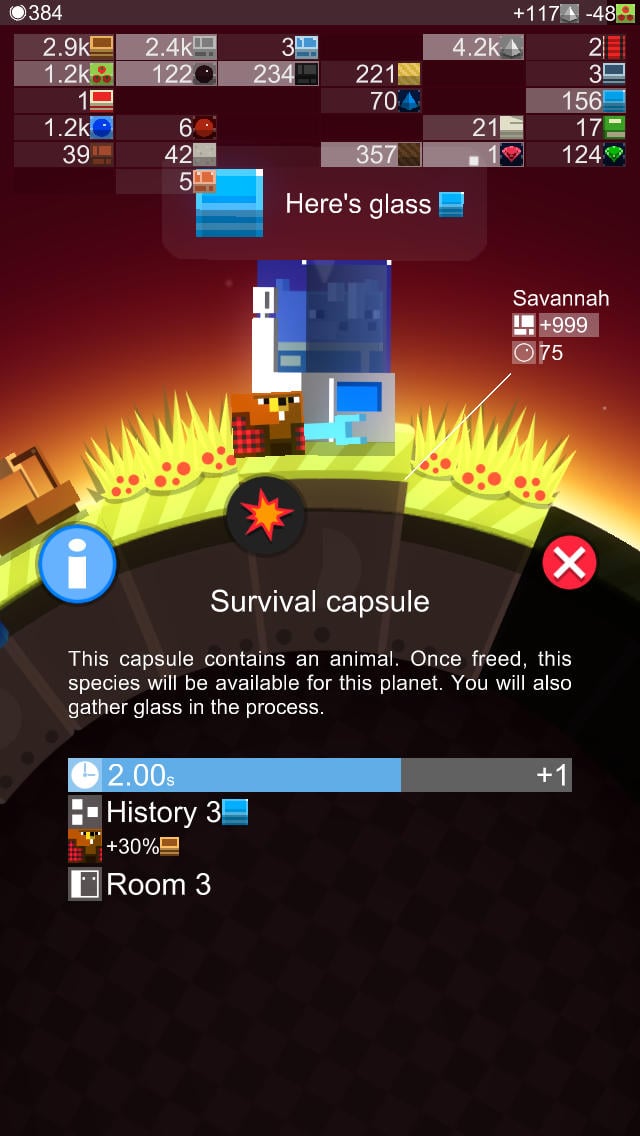
Inhabitants are created randomly from the species that live on that planet. If more than one species currently occupies your planet, when you create a new inhabitant it will randomly be chosen from among the available species. If you colonize a new planet with only one species, only that species will be created on the new planet.
If two species lived on a planet together but one is killed off, then that planet will only produce the remaining species going forward.
Also note that when a new species is added to your society on any planet, every inhabitant—even if they don’t share a planet with that species—will gain its special research bonus. For example: if you’re playing as the Rhinos and you travel to a new planet with Beaverians, all of the Rhinos will gain the Beaverians’ increased construction speed via the “Building” research skill, even those remaining on the original planet. If you’ve noticed research skills showing as unlocked before you’ve selected them or even reached their research tree level, it might be because your current species automatically have them.
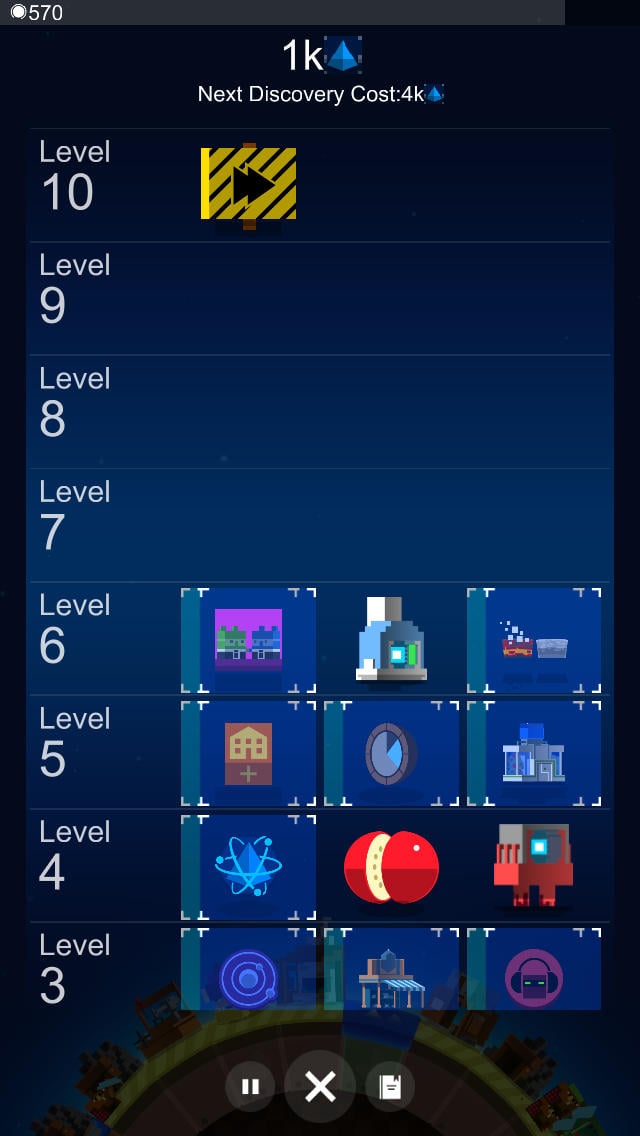
Don’t spend research points unless you really want something. When you level up your civilization via Ascension, you’ll earn a large quantity of Science and access to a new research tree. You can spend your Science on one of the skills available in your research tree to unlock it (for that game only). However, every skill you select doubles the price of the next unlock. So, while your first skill will only cost 500 Science, by the fourth skill you’ll need to save up 4,000 Science. And the amount you earn per Ascension level does not increase. Even with structures which generate Science points, this makes unlocking more than a few research skills extremely difficult.
So, unless you really want a skill at a lower tier level, don’t spend your Science right away. Wait and see if better skills become available with higher Ascension levels. This also means you should try to avoid wasting Science on skills you definitely don’t need: if the scenario you’re playing doesn’t have any hostile AI factions, don’t spend Science on diplomacy or defensive abilities. And remember that you can spend Science at any time, so if you opt to not buy something at first but then change your mind—a hostile faction suddenly appears!—you can always hop into the research menu and purchase a skill from a previous tier.
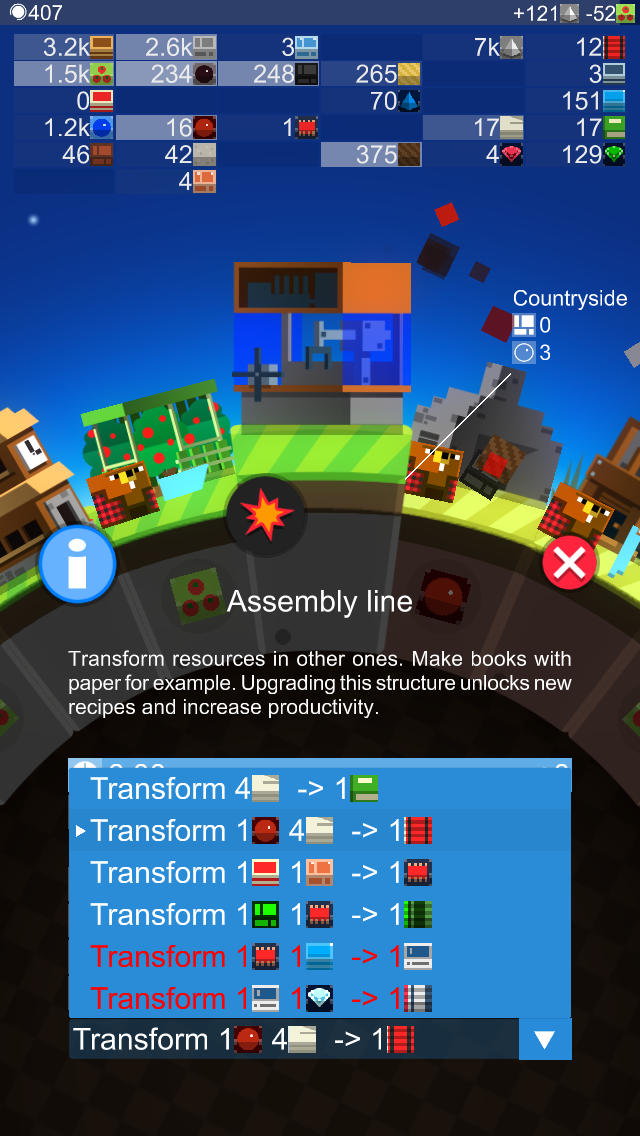
Most production facilities have multiple recipes available: This isn’t obvious right away, but when you tap on a structure that produces resources—such as the plantation, foundry, research lab, etc.—there is a drop-down box at the bottom of the structure’s description. The box will show you what is currently being produced, but if you tap it you can select other recipes. The plantation can generate two redballs directly, or you can assign it to transform one water into three redballs, one fertilizer into four redballs, etc. The foundry makes coal from wood by default, but it can also produce water, glass, concrete, steel, plastic, and bio-gaz simply by switching the current recipe.
If you tap the drop-down box and there are recipes listed in red, this means that the current structure does not have access to the recipe but a later upgrade in that structure chain will. So, on the press, the “25 coal > 1 emerald” recipe is in red and not selectable, but on the assisted press it is available.
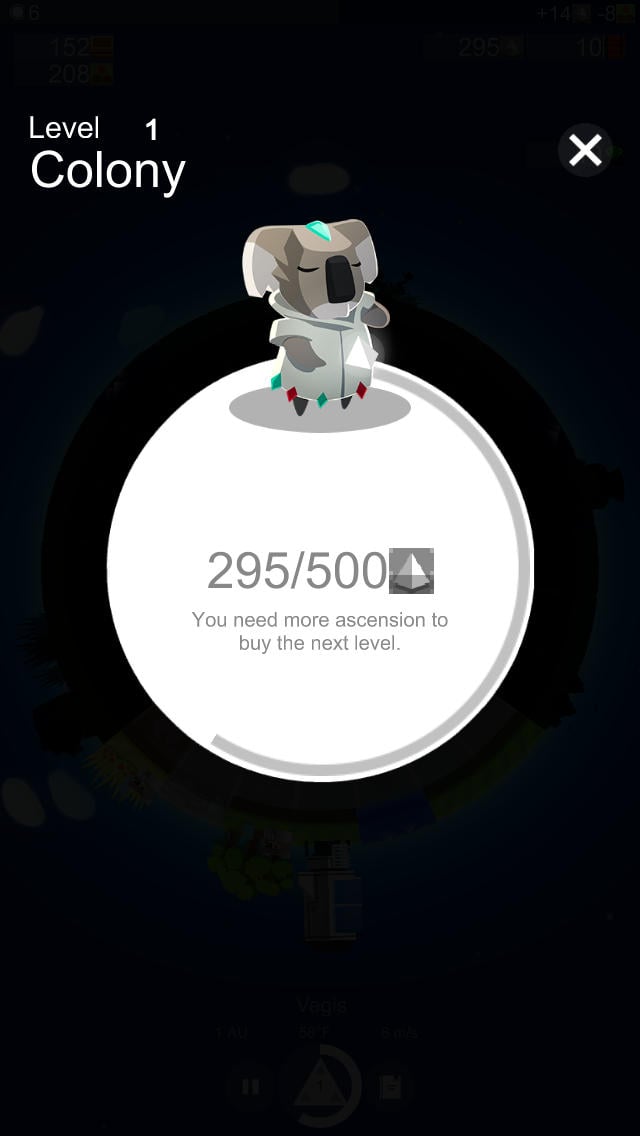
Ascension earned each cycle is based on number of inhabitants. At the end of each planetary cycle (the white bar at the top of the screen), your inhabitants will eat redballs and you will gain Ascension points. The amount of Ascension you gain depends on the species—Beaverians, for instance, gain +5 Ascension per inhabitant while Space Chickens only gain +2—plus any bonuses from structures, etc. Thus, even though it costs Ascension to create inhabitants, that one-time price will result in recurring Ascension rewards over time and inhabitants will recoup their creation cost after only a few cycles.
The maximum Ascension level is 10. Once you reach Ascension level 10, you will no longer be able to level up via Ascension. This unlocks the last research tree and gives you your final stellar map expansion. This also means that there are no new buildings—except any you purchase via Science points in the research tree—to unlock.
Increasing Civilization score quickly: Some of the challenges require you to reach a certain Civilization score, which is the combined total score of all of your planets. Civilization score is different from Ascension or Science points: while the latter two are earned from planetary cycles, certain production facilities, and leveling up and they are both spent as a type of in-scenario currency, Civilization score is based entirely on what you have built and is not spent on anything. A structure’s addition to the Civilization score is listed on its description before or after you build it. A foundry, for instance, is worth +200 Civilization score while as assisted foundry is worth +400.
One way to improve Civilization score is simply by colonizing more planets, which affords you extra space to build more structures. Upgraded structures will always be worth more than their lower tier counterparts. Some structures are designed simply to provide significant Civilization score bonuses, such as the galactic library (20,300 points) and stellar temple (10,400 points).
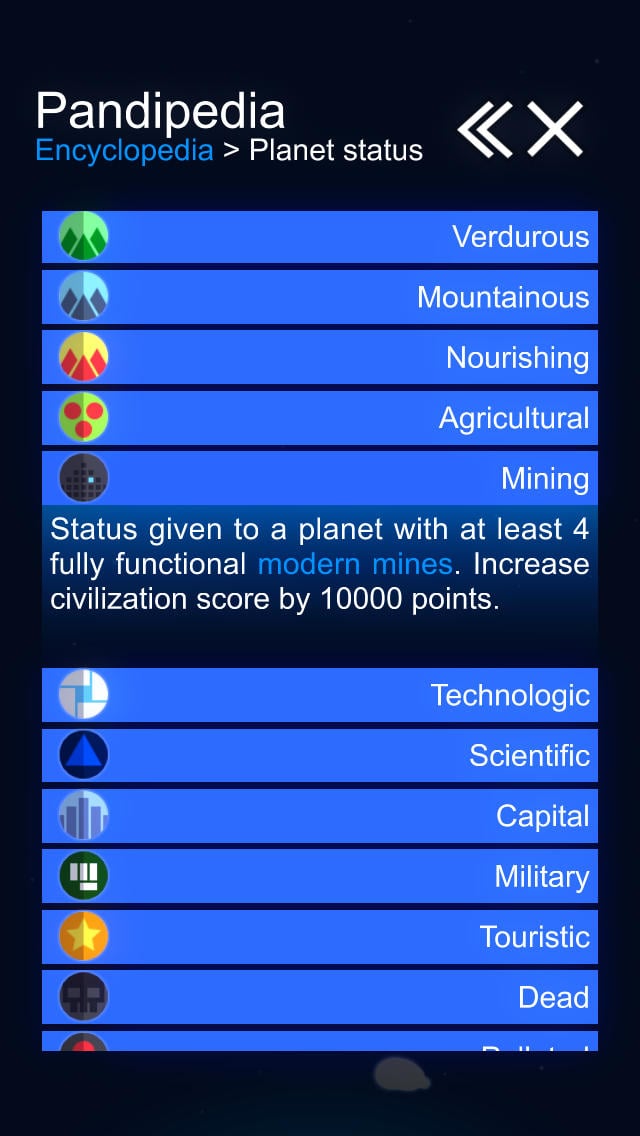
Another way to boost your Civilization score is by achieving specific planet-wide milestones. These are noted as “planet status” in the game’s encyclopedia. They usually involve building a set of structures that, once all completed, will assign a status to your planet and a huge boost in score. The “mining” status, for instance, is given when your planet has four functioning (powered by energy) modern mines. As soon as you earn this status, you’ll receive +10,000 Civilization score.
Note that as soon as you demolish a structure, any Civilization score it was providing will be deducted from your total.
The Beaverians are a good starting species. Although the game’s tutorial uses the Space Chickens as the training species, we recommend using the Beaverians when you’re first playing. They begin with an extra 200 wood, which will allow you to get a jumpstart on any structures you want to build right out of the gate. They also earn a decent amount of Ascension each cycle, at +5 per inhabitant.
Full species list: Below we’ve listed all the available species in the game, along with their starting loadout, favorite resource (that they earn bonus amounts of), appetite (how many redballs they eat each cycle), Ascension accrual (how many Ascension points they receive per inhabitant), preferred biome (where they work fastest), and research skill(s) (which they automatically begin the game with and do not need to buy with Science). All species begin with 100 wood, 200 redballs, 225 Ascension points, and 10 explosives—plus their additional “starting loadout” bonus.
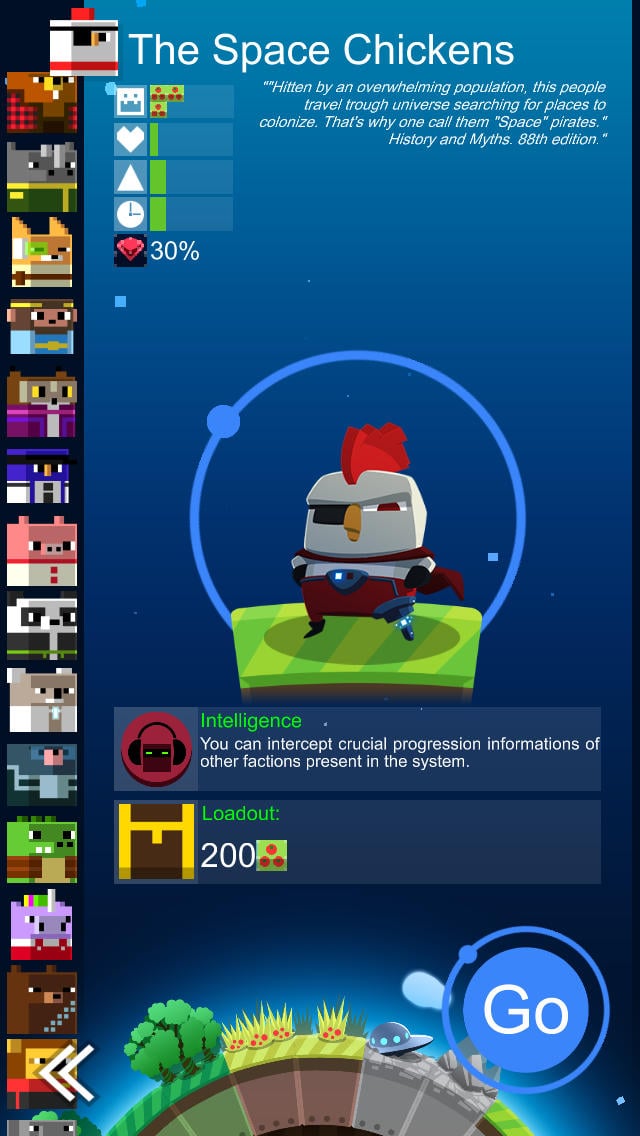
Space Chickens
- Starting loadout: 200 redballs
- Favorite resource: Ruby
- Appetite: 3 redballs per inhabitant
- Ascension accrual: 2 Ascension points per inhabitant
- Preferred biome: Countryside
- Research skill: Intelligence – “You can intercept crucial progression informations of other factions present in the system.”
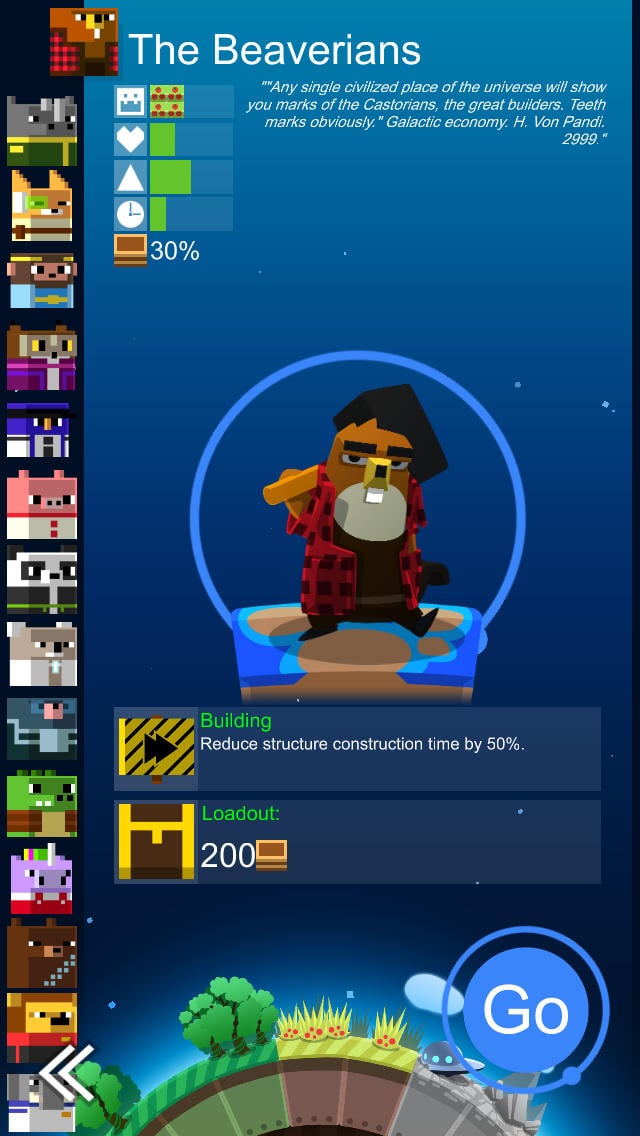
Beaverians
- Starting loadout: 200 wood
- Favorite resource: Wood
- Appetite: 4 redballs per inhabitant
- Ascension accrual: 5 Ascension points per inhabitant
- Preferred biome: Swamp
- Research skill: Building – “Reduce structure construction time by 50%.”
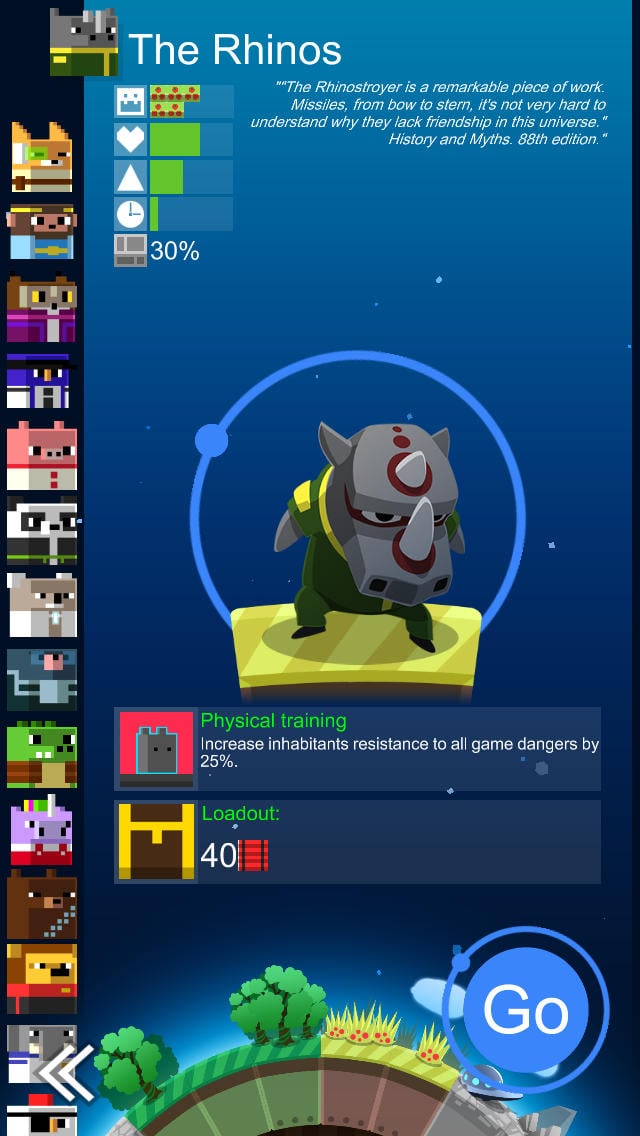
Rhinos
- Starting loadout: 40 explosives
- Favorite resource: Stone
- Appetite: 5 redballs per inhabitant
- Ascension accrual: 4 Ascension points per inhabitant
- Preferred biome: Savannah
- Research skill: Physical Training – “Increase inhabitants resistance to all game dangers by 25%.”
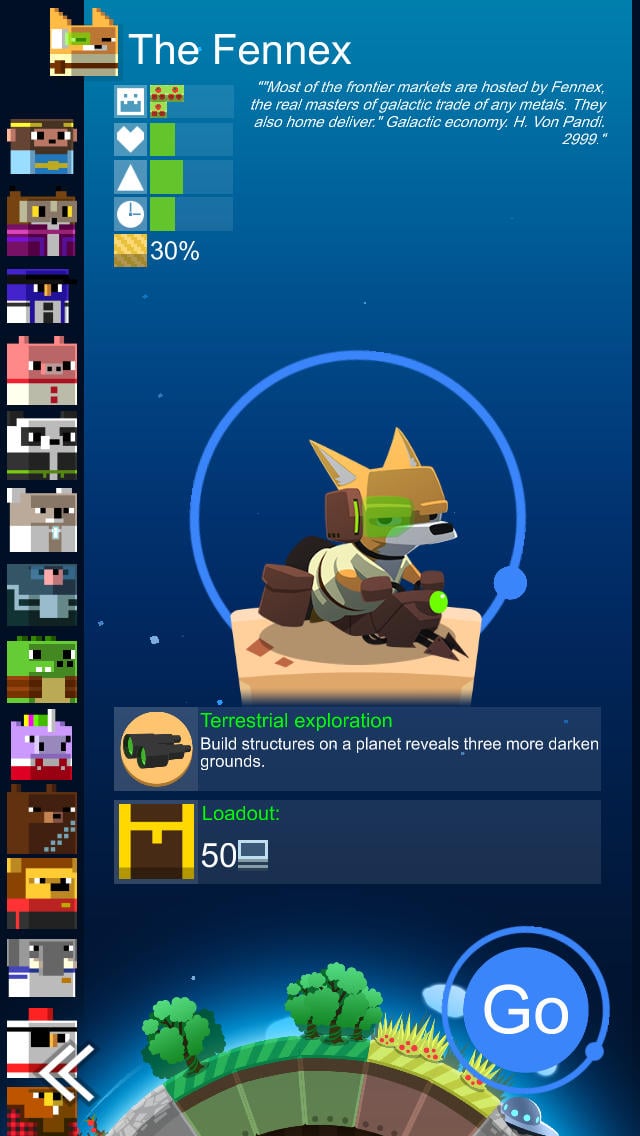
Fennex
- Starting loadout: 50 steel
- Favorite resource: Sand
- Appetite: 3 redballs per inhabitant
- Ascension accrual: 4 Ascension points per inhabitant
- Preferred biome: Desert
- Research skill: Terrestrial Exploration – “Build structures on a planet reveals three more darken grounds.”
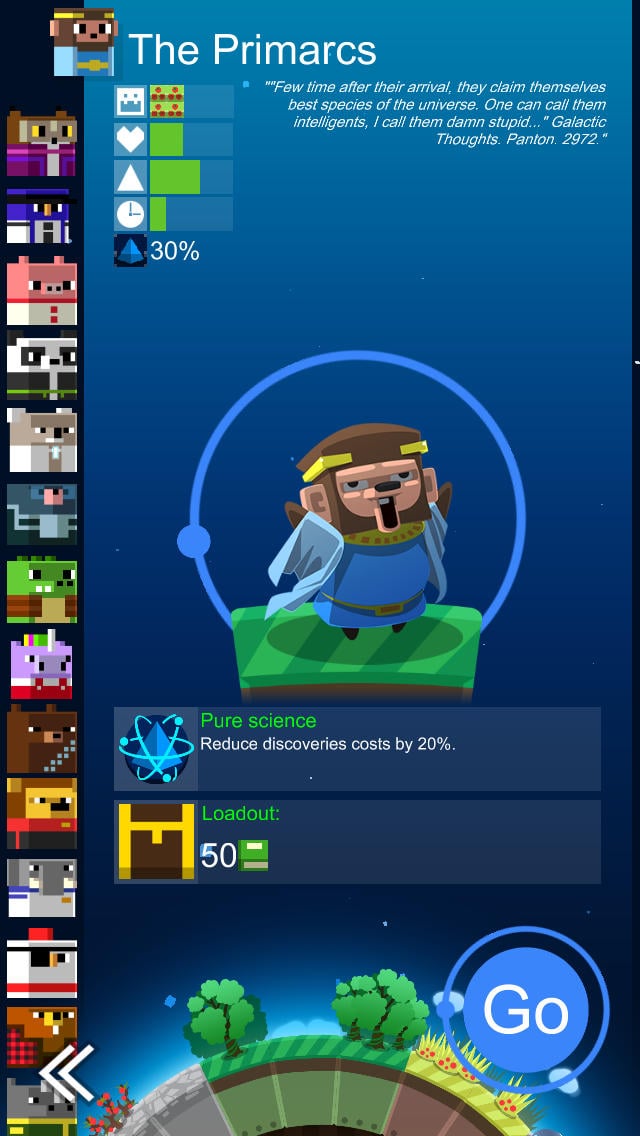
Primarcs
- Starting loadout: 50 books
- Favorite resource: Science
- Appetite: 4 redballs per inhabitant
- Ascension accrual: 6 Ascension points per inhabitant
- Preferred biome: Jungle
- Research skill: Pure Science – “Reduce discoveries costs by 20%.”
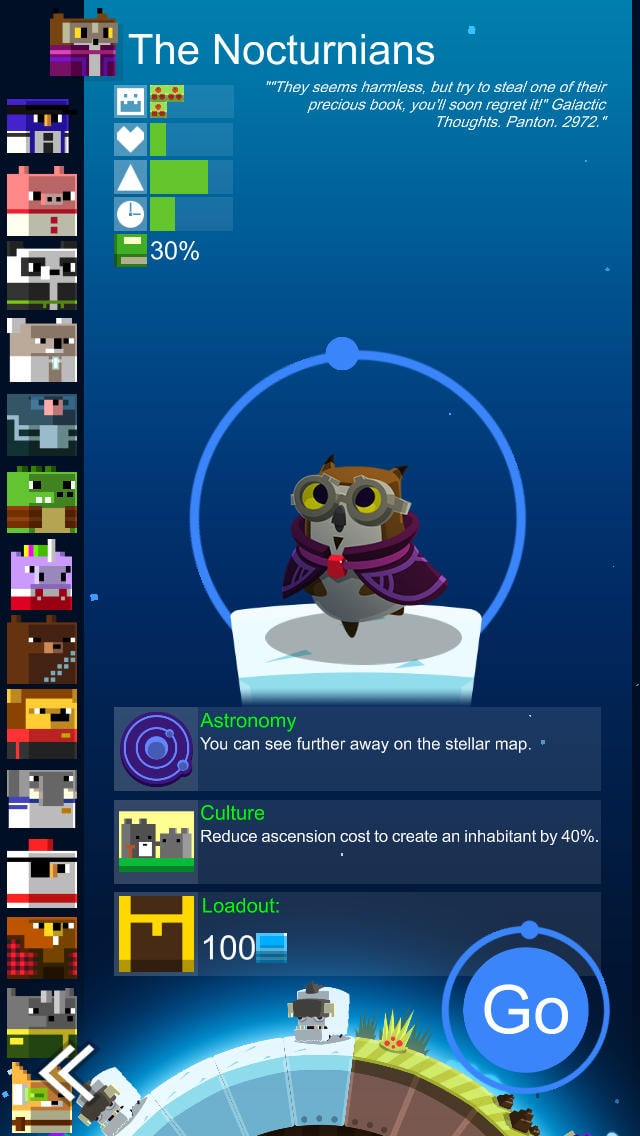
Nocturnians
- Starting loadout: 100 glass
- Favorite resource: Books
- Appetite: 3 redballs per inhabitant
- Ascension accrual: 7 Ascension points per inhabitant
- Preferred biome: Permafrost
- Research skills: Astronomy – “You can see further away on the stellar map.”
Culture – “Reduce Ascension cost to create an inhabitant by 40%.”
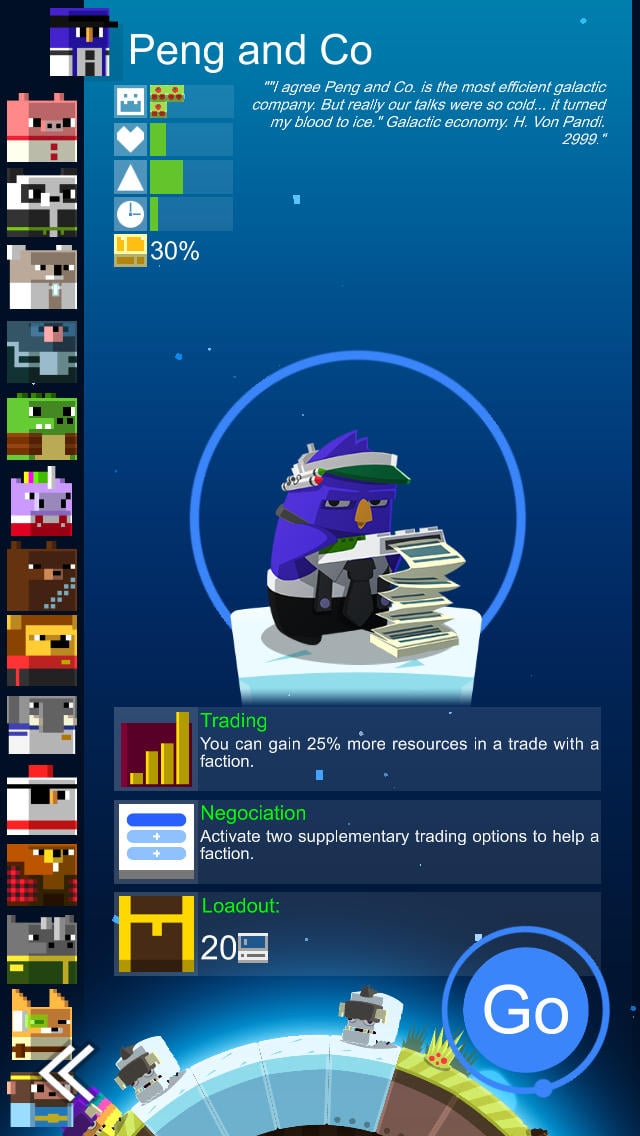
Peng and Co
- Starting loadout: 20 computers
- Favorite resource: Gold
- Appetite: 3 redballs per inhabitant
- Ascension accrual: 4 Ascension points per inhabitant
- Preferred biome: Permafrost
- Research skills: Trading – “You can gain 25% more resources in a trade with a faction.”
Negotiation – “Activate two supplementary trading options to help a faction.”
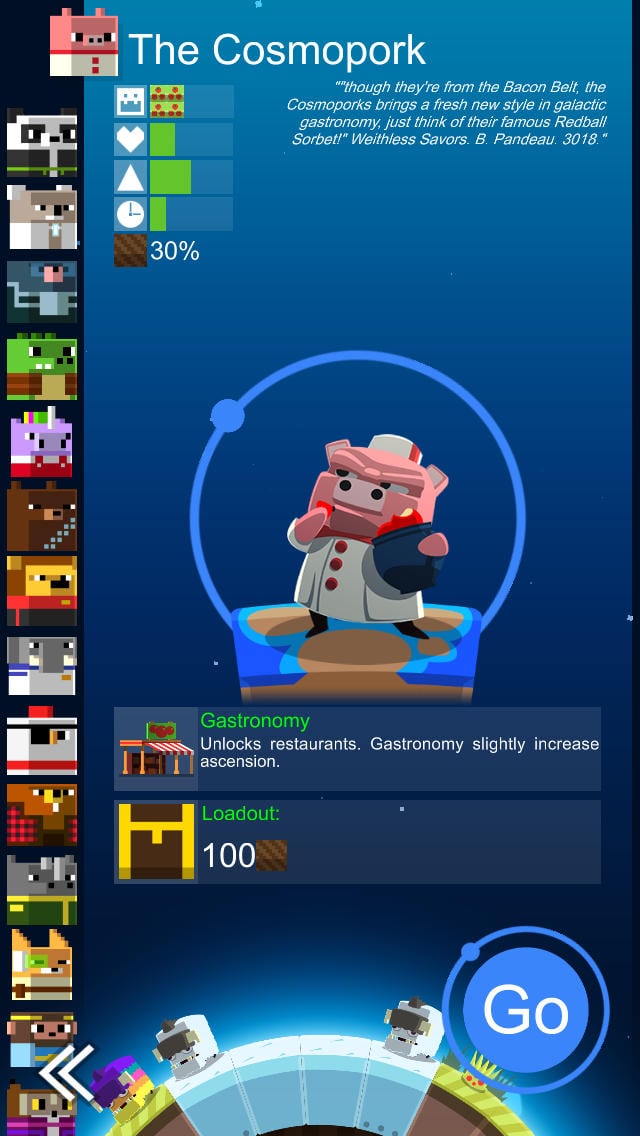
Cosmopork
- Starting loadout: 100 fertilizer
- Favorite resource: Fertilizer
- Appetite: 4 redballs per inhabitant
- Ascension accrual: 5 Ascension points per inhabitant
- Preferred biome: Swamp
- Research skill: Gastronomy – “Unlocks restaurants. Gastronomy slightly increase Ascension.”
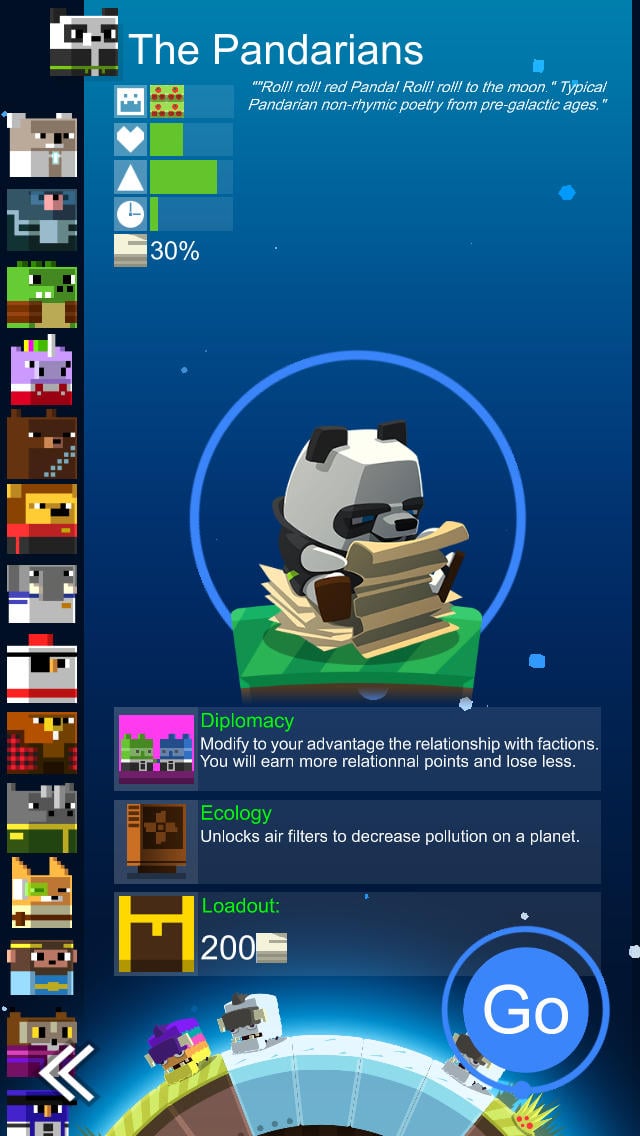
Pandarians
- Starting loadout: 200 paper
- Favorite resource: Paper
- Appetite: 4 redballs per inhabitant
- Ascension accrual: 8 Ascension points per inhabitant
- Preferred biome: Jungle
- Research skills: Diplomacy – “Modify to your advantage the relationship with factions. You will earn more relational points and lose less.”
Ecology – “Unlocks air filters to decrease pollution on a planet.”
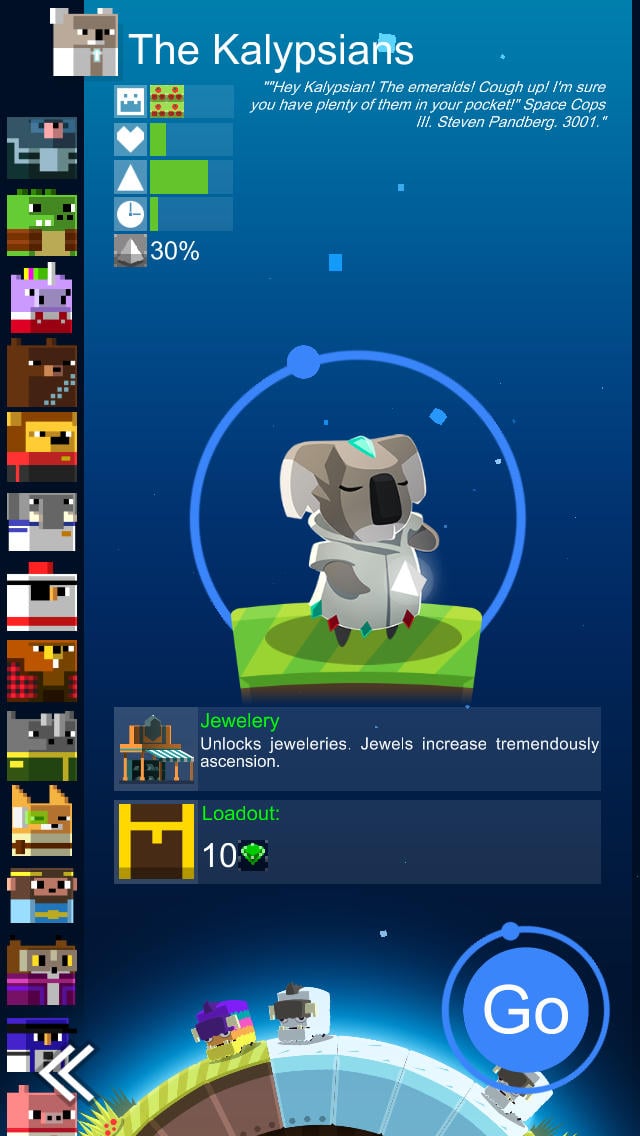
Kalypsians
- Starting loadout: 10 emerald
- Favorite resource: Ascension
- Appetite: 4 redballs per inhabitant
- Ascension accrual: 7 Ascension points per inhabitant
- Preferred biome: Countryside
- Research skill: Jewelry – “Unlocks jewelries. Jewels increase tremendously Ascension.”
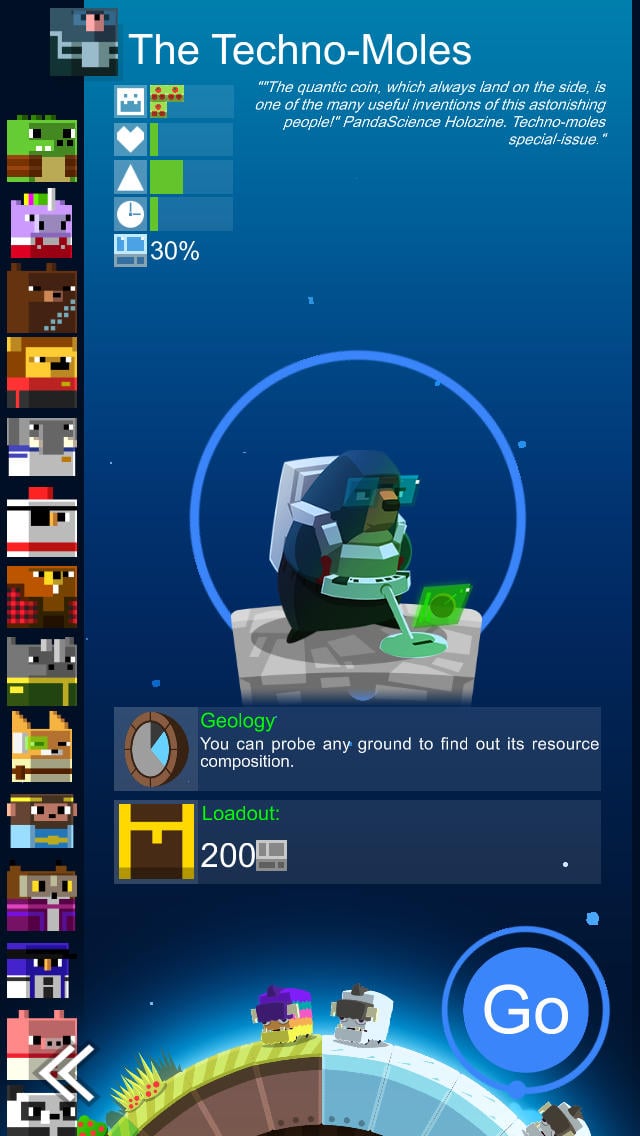
Techno-Moles
- Starting loadout: 200 stone
- Favorite resource: Iron
- Appetite: 3 redballs per inhabitant
- Ascension accrual: 4 Ascension points per inhabitant
- Preferred biome: Rocky
- Research skill: Geology – “You can probe any ground to find out its resource composition.”
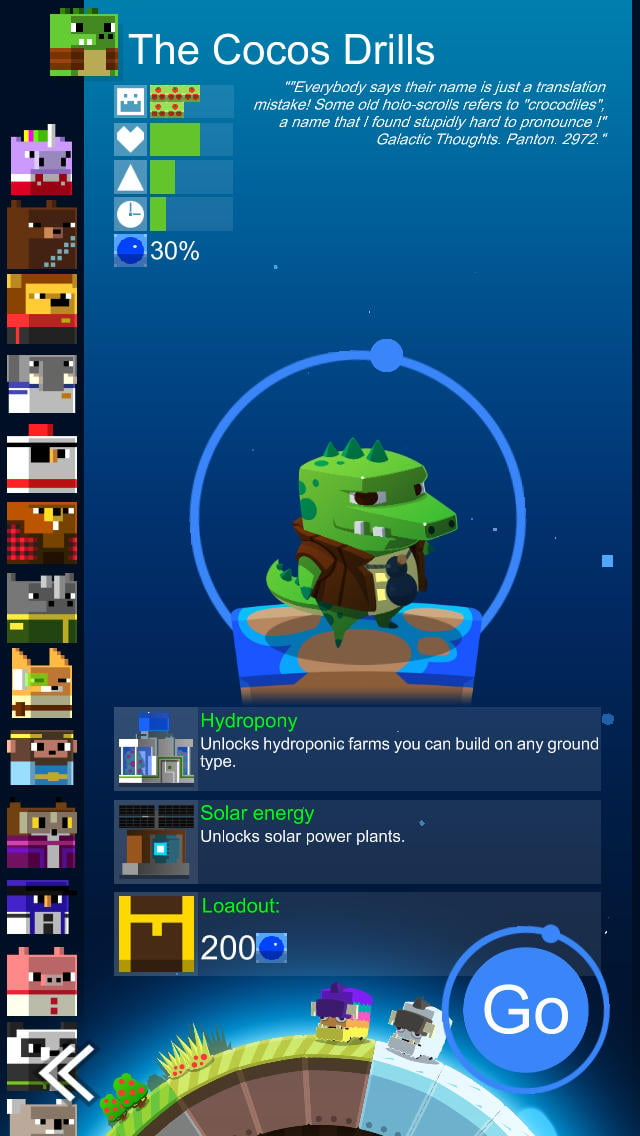
Cocos Drills
- Starting loadout: 200 water
- Favorite resource: Water
- Appetite: 5 redballs per inhabitant
- Ascension accrual: 3 Ascension points per inhabitant
- Preferred biome: Swamp
- Research skills: Hydropony – “Unlocks hydroponic farms you can build on any ground type.”
Solar energy – “Unlocks solar power plants.”
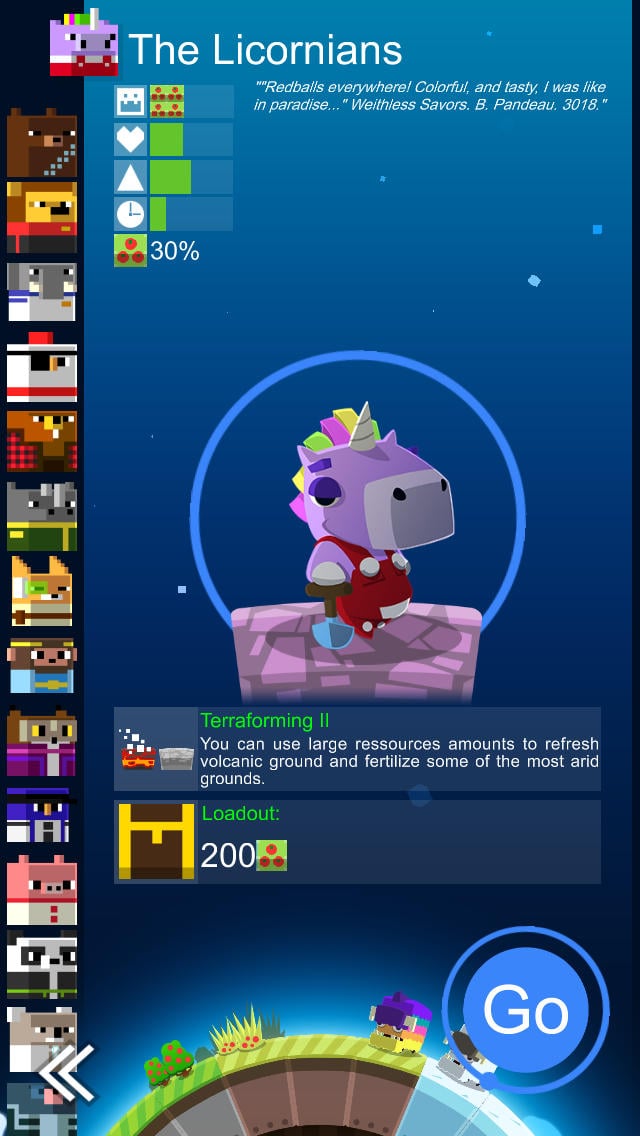
Licornians
- Starting loadout: 200 redball
- Favorite resource: Redball
- Appetite: 4 redballs per inhabitant
- Ascension accrual: 5 Ascension points per inhabitant
- Preferred biome: Netheriumiferous
- Research skill: Terraforming II – “You can use large resources amounts to refresh volcanic ground and fertilize some of the most arid grounds.”
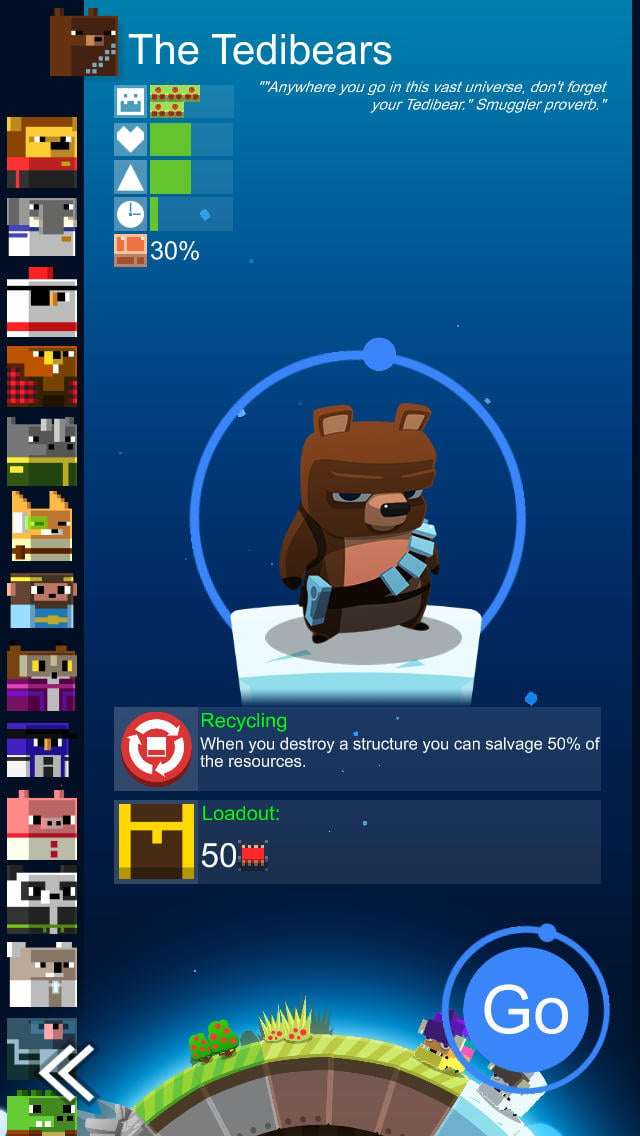
Tedibears
- Starting loadout: 50 tech stuff
- Favorite resource: Copper
- Appetite: 5 redballs per inhabitant
- Ascension accrual: 5 Ascension points per inhabitant
- Preferred biome: Permafrost
- Research skill: Recycling – “When you destroy a structure you can salvage 50% of the resources.”
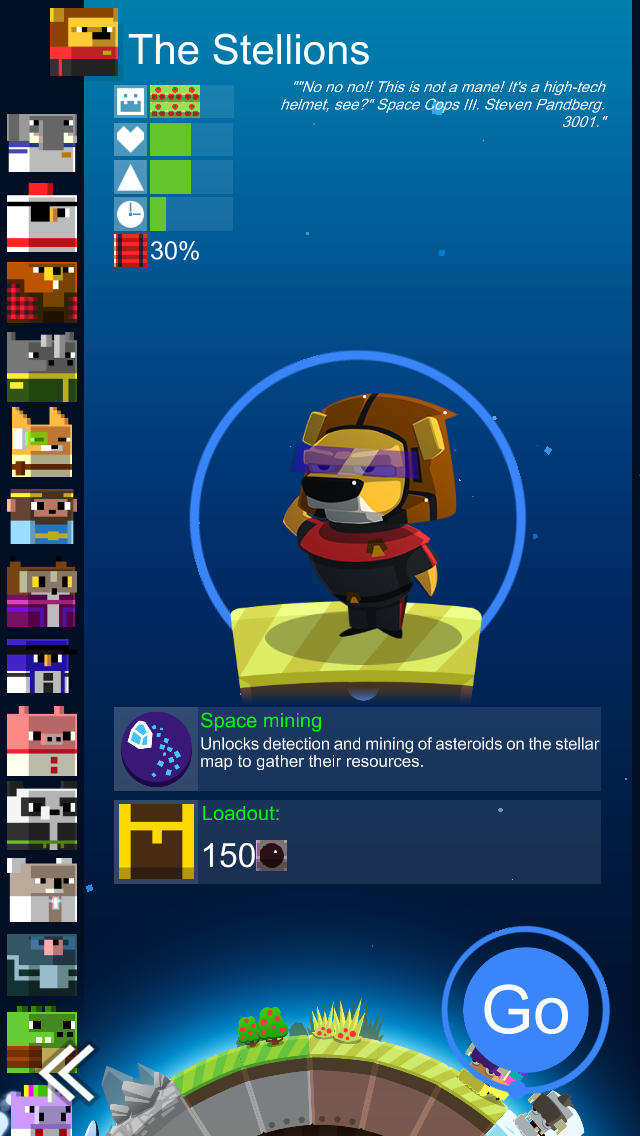
Stellions
- Starting loadout: 150 oil
- Favorite resource: Explosives
- Appetite: 6 redballs per inhabitant
- Ascension accrual: 5 Ascension points per inhabitant
- Preferred biome: Savannah
- Research skill: Space Mining – “Unlocks detection and mining of asteroids on the stellar map to gather their resources.”
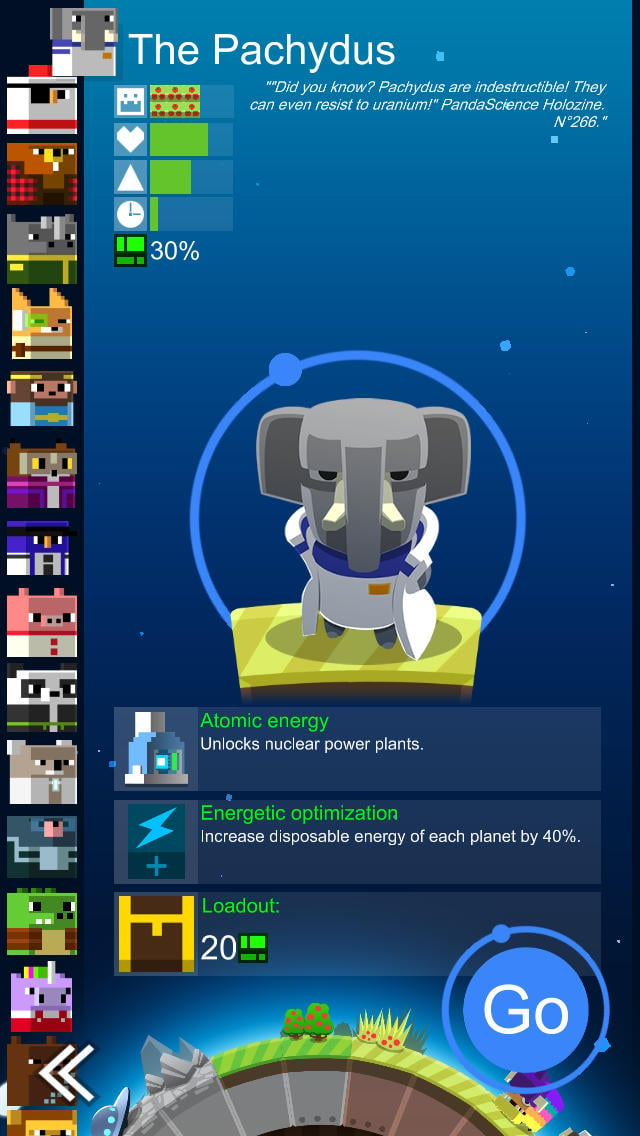
Pachydus
- Starting loadout: 20 uranium
- Favorite resource: Uranium
- Appetite: 6 redballs per inhabitant
- Ascension accrual: 5 Ascension points per inhabitant
- Preferred biome: Savannah
- Research skills: Atomic Energy – “Unlocks nuclear power plants.”
Energetic Optimization – “Increase disposable energy of each planet by 40%.”
More articles...
Monopoly GO! Free Rolls – Links For Free Dice
By Glen Fox
Wondering how to get Monopoly GO! free rolls? Well, you’ve come to the right place. In this guide, we provide you with a bunch of tips and tricks to get some free rolls for the hit new mobile game. We’ll …Best Roblox Horror Games to Play Right Now – Updated Weekly
By Adele Wilson
Our Best Roblox Horror Games guide features the scariest and most creative experiences to play right now on the platform!The BEST Roblox Games of The Week – Games You Need To Play!
By Sho Roberts
Our feature shares our pick for the Best Roblox Games of the week! With our feature, we guarantee you'll find something new to play!All Grades in Type Soul – Each Race Explained
By Adele Wilson
Our All Grades in Type Soul guide lists every grade in the game for all races, including how to increase your grade quickly!







